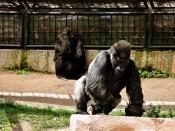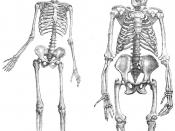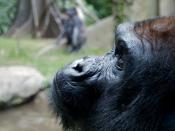Central Africa's Orphan Gorillas
The Orphans were dependent on the project protection des Gorillas (PPG.) This 12 yr. old project searches for orphaned gorillas rescues and raise them in a healthy group environment to be released into one of two sanctuaries Congo and Gabon. Although there real origins are unsure most were probably "bush-meat orphans": Their mothers killed by hunters who butcher and smoke the meat in jungle camps to be shipped to cities and villages across the country. The babies most likely would have been kept captive afterward and sold as pets. If not saved from that fate nearly all perish from disease, malnutrition or depression they are weak and rely upon the care and emotion support of there mothers for as long as eight years.
Walking with these lucky little ones by day, and sleeping in a dormitory loft above them at night we would get an impressive view of the western lowland gorilla.
Although well represented in zoological gardens and more numerous in the wild than the other two gorilla subspecies the eastern lowland gorillas. The western subspecies has been the more obscure because of it's swampy jungle habitat.
PPG slowly weans the orphans from human reliance into forming social groups lead by a dominant male returning to their natural way of life in the wild. While developing families the staff logs hundreds of hours of observation recording a variety of behaviors. Their data contributes to better understanding of the subspecies whose numbers are believed to be around 100,000 and decreasing.
At 7:30 the gorillas receive their daily formula and at 8:00 they rush from their cages. After the confusion the youngsters are gathered and spend the day amongst the shade near the dormitory. The infants can venture farther into the forest with more staff supervision.
One sunny day two women lead us across the savanna into the forest. Kabo and Makoua two males were leading the way neither was mature or experienced enough but circumstances put the duty upon them. Makoua looked after three females, Bougou, Lengui, and Loubomo. Kabo watches over Bangha, a young male and Mayoko, a pregnant female. Mayoko pregnancy is PPG's first a sign that the orphans were settling into their social environment though artificial.
One morning McConnery and I decided on a walk the juveniles ambling and pounding their chests in a mock display ahead of us. We paused once in a while as the gorillas explored their surroundings. The infants learned which plants were edible by watching the older orphans who maintained some knowledge from their parents. We watched a wrestling match and then they climbed the trees swinging from the vines. Koto crawled into my lap and stared into the treetop falling asleep snoring. The life she might have known with her mom was gone. The staff still hoped she would become a gorilla again not needing to snuggle in a humans lap for security.
Six months after are stay with the Tchimpounga orphans would be transferred to the Lesio Louna Sanctuary in the Lefini Reserve. There, Despina a Greek woman cares for them. She was not schooled as a field biologist, and her work does not follow strict rules for scientific research. She describes gorilla social ladder in anthropomorphic terms.
John Aspinall underwrites the PPG program; late last year he finalized plans to translocate two gorillas to Mphassa, fulfilling a lifelong dream.


